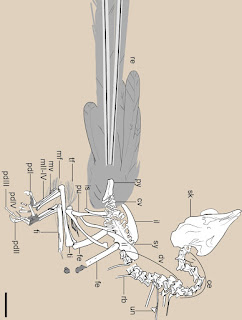 |
| Yuanchuavis kompsosoura Wang, O’Connor, Zhao, Pan, Zheng, Wang & Zhou, 2021 Illustration: Haozhen Zhang |
 |
On the cover: An early Monday morning during the Early Cretaceous of Asia. A male Yuanchuavis is displaying and perching on the crest of a sleepy Sinotyrannus when they are suddenly interrupted by a flock of tiny, young Sinopterus (Nemicolopterus). In this issue, Wang et al. (pages 4845–4852) report a new Early Cretaceous enantiornithine bird, Yuanchuavis kompsosoura, with a rectricial fan combined with an elongated central pair of fully pennaceous rachis-dominated plumes, constituting a new tail plumage previously unknown among dinosaurs and Mesozoic birds but that strongly resembles the pintail in many living birds. |
Highlights:
• Wang et al. describe a new pengornithid enantiornithine from the Early Cretaceous
• The new enantiornithine specimen preserves a pintail indicative of sexual selection
• The exaggerated pintail of this fossil bird may arise from the handicap process
• Mesozoic enantiornithines and ornithuromorphs show contrasting tail morphotype
Summary
Enantiornithes are the most successful group of Mesozoic birds, arguably representing the first global avian radiation, and commonly resolved as the sister to the Ornithuromorpha, the clade within which all living birds are nested. The wealth of fossils makes it feasible to comparatively test evolutionary hypotheses about the pattern and mode of eco-morphological diversity of these sister clades that co-existed for approximately 65 Ma. Here, we report a new Early Cretaceous enantiornithine, Yuanchuavis kompsosoura gen. et sp. nov., with a rectricial fan combined with an elongate central pair of fully pennaceous rachis-dominated plumes, constituting a new tail plumage previously unknown among nonavialan dinosaurs and Mesozoic birds but which strongly resembles the pintail in many neornithines. The extravagant but aerodynamically costly long central plumes, as an honest signal of quality, likely evolved in enantiornithines through the handicap process of sexual selection. The contrasting tail morphotypes observed between enantiornithines and early ornithuromorphs reflect the complex interplay between sexual and natural selections and indicate that each lineage experienced unique pressures reflecting ecological differences. As in neornithines, early avialans repeatedly evolved extravagant structures highlighting the importance of sexual selection in shaping the plumage of feathered dinosaurs, even early in their evolutionary history.
Keywords: Aves, dimorphism, Enantiornithes, feather, phylogeny, Mesozoic, Ornithuromorpha, sexual selection
Min Wang, Jingmai K. O’Connor, Tao Zhao, Yanhong Pan, Xiaoting Zheng, Xiaoli Wang and Zhonghe Zhou. 2021. An Early Cretaceous enantiornithine Bird with A Pintail. Current Biology. In Press. DOI: 10.1016/j.cub.2021.08.044













